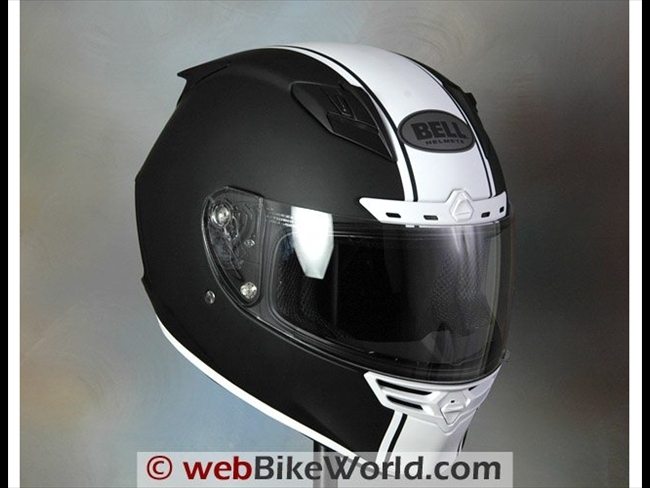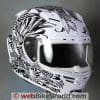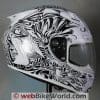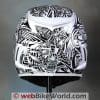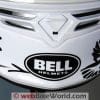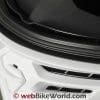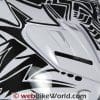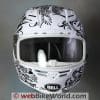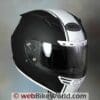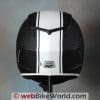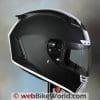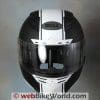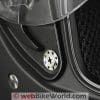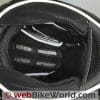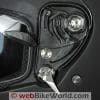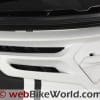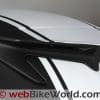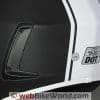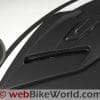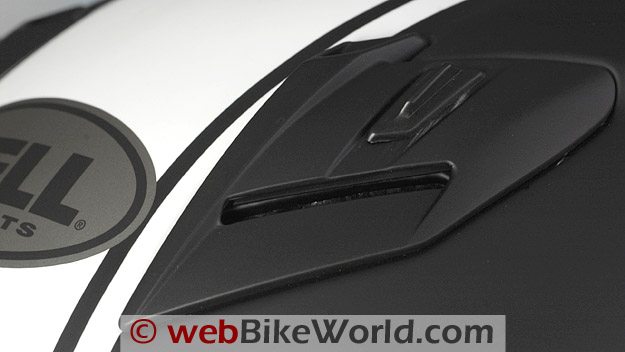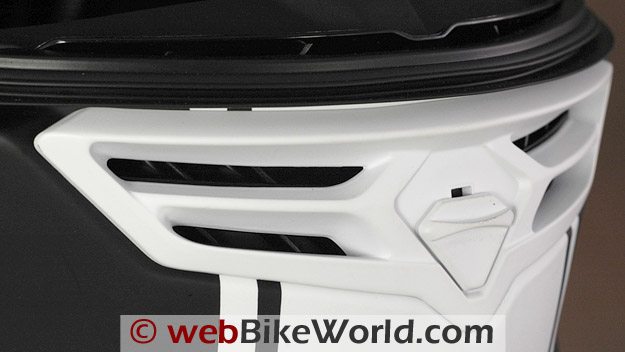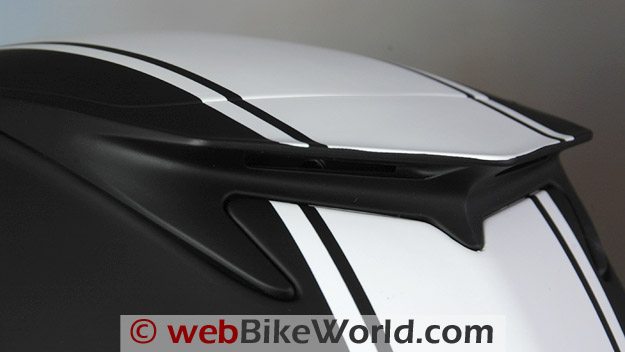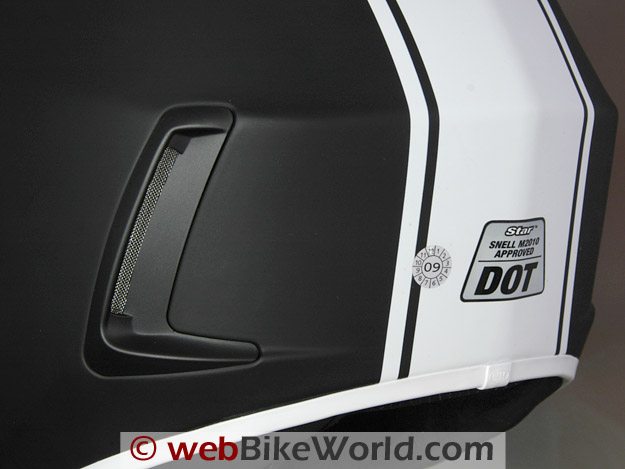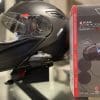Just two years from the re-launch of one of the most famous motorcycle helmets of all time, the Bell Star has been updated for 2010.
The updated Bell Star has new features, a slightly different head shape and Snell 2010 safety standard approval.
The 2010 Bell Star has outstanding quality and fantastic ventilation, along with many other excellent features that make it a true standout.
The Bell Star was one of the most recognized helmet names in the world back in the day and Bell is aiming to resurrect that prestige with the latest version of the helmet.
It started — or restarted — again in 2008, when the company announced the new Bell Star at that year’s Powersports Dealer Expo in Indianapolis, which was covered live on webBikeWorld.com (more).
Once the production line was up and running, a new Bell Star found its way to webBikeWorld and it was reviewed in June of that year.
The helmet was (and is) different and unique and it had (and has) lots of very leading-edge features.
But the internal shape of the original was biased towards narrow, putting it a couple of standard deviations away from the type of fit that works the majority of motorcyclists.
Just two years later, Bell took the opportunity during a redesign to meet the Snell 2010 standard to also change the internal fit to a more neutral shape, while also improving on a few other features to make the helmet even better.
I’ll describe some of the differences in this review, but let me start off by saying that the two Bell Star helmets shown here have absolutely superb quality in terms of their construction and paint and graphics, which has left me and others very impressed.
There’s something about these new Bell Star helmets that goes beyond just the numbers too.
Pulling these helmets out of the box for the first time and touching the surfaces and fittings gave me one of those subjective and difficult-to-describe feelings that the Bell Star really is something different from the average helmet, no matter the brand or price.
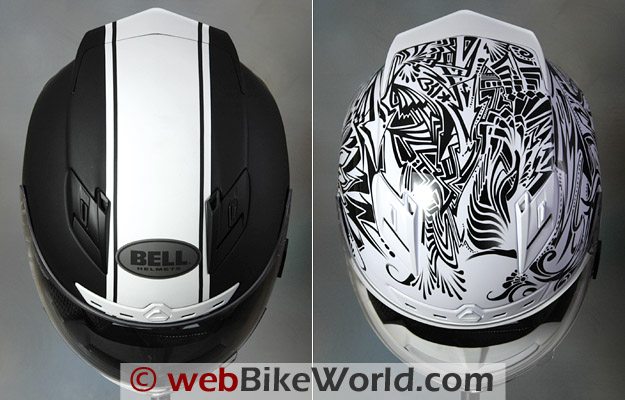
Bell Star Paint, Graphics and Overall Quality
Bell went all out with graphics for the updated Star helmet, making it very difficult to choose a favorite color combination.
The Star has a very unique shape that simply demands a proper graphic design as a compliment and I think all of the current patterns do just that.
The interesting thing is that both the wild black and white “Cerwinske” version shown here and the much simpler matte black and white “Rally” version both compliment the unique shape of the Bell Star, with its most recognizable feature, the “Sonic the Hedgehog” rear spoiler.
At least that’s what I call it, because it reminds me of the famous video game character!
When I first saw the Cerwinske graphics, I had some vague recollection of the name. “Hmmm, Cerwinske — where have I heard that name before? He’s an AMA motorcycle racer, right?” Wrong. Shows how street-smart I am.
As it turns out, Bell did something very interesting by creating an “Artist Series” for certain Bell Star Helmets. The Cerwinske design is named for the famous street artist Jona Cerwinske.
The concept and the helmet design are very cool indeed — and check out more of Cerwinske’s incredible work like the white Lamborghini Gallardo done entirely with a black Sharpie pen!
Think of a black and white combination of M.C. Escher and Rick Griffin and you’ll pretty much have a good idea of Jona Cerwinske.
The Cerwinske graphics have been hugely popular with Bell Star customers, according to the company.
The version shown here has white colored plastic used in the chin vent, rear vents and other fittings, while a Cerwinske carbon fiber version is also available, with black colored fittings.
Besides the fantastic designs and the quality of the application on both of these helmets, they also have what I can only call perfect quality for everything else.
There’s nothing out of place — the vents, surrounds, liner and even the face shield are all beautifully made and everything is assembled to perfection.
All of this is what adds to that strong out-of-the-box first impression. It’s a helmet you can be proud to own and wear, even if it is admittedly a bit on the expensive side.
Besides, the 5-year warranty provided by Bell goes a long way toward mitigating the dent on the wallet.
And one more thing: Bell positively gives the best helmet bags in the business with the Bell Star.
This isn’t some cheap sack that ends up in the bottom of the helmet box; it’s an honest piece of soft luggage they could probably charge $49.95 for and no one would blink.
Score: The Bell Star 2010 gets an “Outstanding” rating from me for overall for quality and design. All of the vents and the face shield work smoothly and confidently. See the Summary Table at the end of this page for a description of our rating system.
Bell Star 2010 Helmet Fit, Comfort and Internal Shape
The biggest problem we had with the original Bell Star was the fit. It was definitely skewed towards the narrow end of the spectrum, which wasn’t a problem for those with “long oval” head shapes but was for the other 66% or so potential owners.
The liner on the 2008 version didn’t help; it had a few seams that conspired with the narrow internal shape to make it somewhat uncomfortable even if it did match the rider’s head shape.
That has been changed in the new 2010 version; apparently Bell took the opportunity during the redesign prompted by Snell 2010 standards to change both the internal shape and the liner.
The new version has a neutral to slightly narrow shape — but it’s a good compromise, and certainly better than the 2008 version, in my opinion. This one is not too round and not too narrow and it should fit a much wider array of head shapes than before.
Those with very round heads may find that the upper sides of the helmet will feel tight, but neutral and narrower shaped heads should have no problems.
The Cerwinske helmet shown in the photos is a size XL and the Rally version is a size L, which allowed us to accurately determine how the sizes affected the internal shape and also the helmet weight.
The XL and XXL use the largest size shell while the M and L use the medium-sized shell and the XS and S use the smallest shell size.
The shells feel nicely proportioned and the XL doesn’t feel or look too big, even though it uses the largest shell size, although the trim “race” style shell sizing does mean there is just a touch less room behind the chin bar than average.
The Bell “TriMatrix” shell is made from a combination of Kevlar, carbon fiber and fiberglass, so it is both light weight and strong.
This type of composite material is used on high-end race helmets rather than the cheaper — and heavier — polycarbonate used in cheap helmets.
The Bell size chart is accurate; it indicates that a 59-60 cm head fits the size L and a 61-62 cm head fits the XL.
Based on our two helmets, this is right on the mark. I also think that if your head size is borderline, like 60.5 cm, you should be fine to go with the smaller helmet size.
The liner material isn’t as plush as the fabric used in the higher end Arai or Shark helmets, but it does seem to have very good moisture wicking capabilities.
Although the padding and the seams have been rearranged from the 2008 Bell Star, the padding is still a bit on the thin side. But, the benefit of this is the incredible air flow through the new Bell Star, which I’ll describe in a minute.

Bell also redesigned the ear pockets on the 2010 Star specifically for speakers.
The ear pockets are very well defined, with a section of padded helmet liner covering the cavity, along with some foam and other material in the pocket itself that can be removed, cut, modified or customized to fit speakers.
The chin strap padding is nicely designed and comfortable, and the 2010 Bell Star has another trick: the first-of-its-kind magnetic chin strap retainer, which definitely comes under the “Why didn’t I think of that?” category!
Overall, the 2010 version of the Bell Star is a comfortable helmet that becomes even more so when your head shape exactly profiles the interior of the helmet.
More information on helmet fit can be found in the chart that lists the helmet weights of webBikeWorld reviewed helmets and also by shape on the webBikeWorld Motorcycle Helmet Shapes page.
Score: I’ll give the 2010 Bell Star an “Excellent” rating for overall comfort and fit.
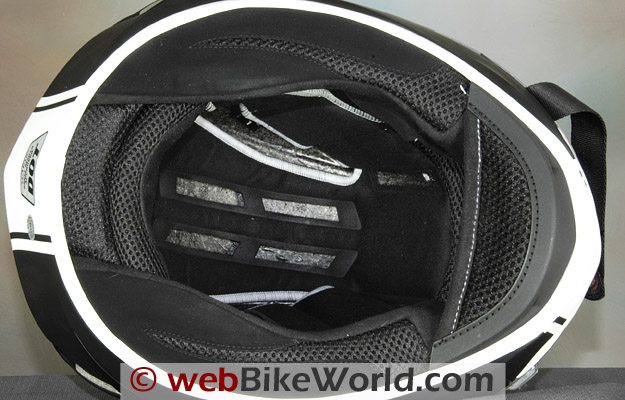
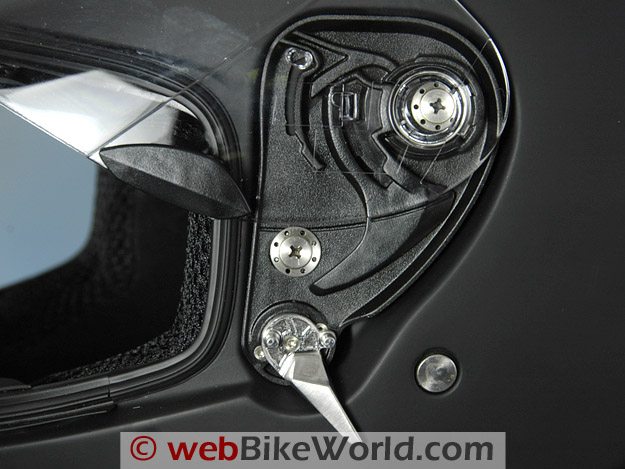
Bell Star Face Shield
I don’t fully recall the 2008 version of the Bell Star and we no longer have the helmet for comparison. But we all agree that the face shield system on the 2010 version is about the best in the business.
The genius of the design is that it seems so simple when you look at it, which makes one wonder how so many other companies can get it so wrong.
The face shield has the standard lifting tab on the lower left-hand side. But the rotating mechanism works very smoothly and precisely and there is no twist or torque on the face shield as it is moved up and down.
It has a precision feel that only needs a light touch — yet the shield snaps into place up and down and can be locked when closed.
Lifting the tab clicks the face shield into the first open position that can be used for ventilation or heavy defogging.
After that, the shield goes through 15 total micro-clicks as it’s rotated upwards to the top of its travel, where it then snaps into place in the fully opened position.
The beauty of it all is that this doesn’t take some exotic and complicated or fragile mechanism; in fact, the mechanism appears to be so simple that it’s astounding.
The rotating mechanism has way fewer moving parts and molded bits than just about any other motorcycle helmet I can think of, yet this one works like a charm, even when it comes time to remove the shield, which is as easy as it gets, as you can see illustrated in the video (below).
Bell even uses drilled aluminum hardware to attach it to the sides of the helmet. These bits look like they came off a piece of surgical equipment or maybe the Hubble telescope or something.
Also, the face shield has a molded and milled aluminum lever on the left-hand side, which can be rotated through three positions.
The rearmost position locks the face shield closed so it won’t blow open unexpectedly whilst riding or racing; the middle position is neutral and the forward position will crack the face shield open just a touch for defogging.
The face shield closes over a full-length gasket that surrounds the entire eye port. It’s a complex molded piece that creates a positive seal to keep out air and moisture.
We gave it the webBikeWorld “Eye Port Gasket Water Torture Test” and it passed with flying colors. The water is quickly channeled out the sides and down off the helmet, so no problems at all with leaking here.
The face shield is also marked as meeting VESC-8 safety standards. It has excellent optical qualities and Bell says it is coated with something called “NutrFog II”, along with an anti-scratch and UV coating.
The anti-fog coating seems to work; although Spring has finally arrived, on cool mornings the shield does not fog anywhere near some of the other helmets in the webBikeWorld inventory.
(In any case, be sure to get a bottle of the easy-to-use Clarity Defog It (review) anti-fog coating just in case! – Editor).

Overall, the new 2010 Bell Star has an outstanding face shield design that is easy to use; the face shield has excellent quality optics, seals tightly, is easy to remove and replace and it feels sturdy and reliable; more so than many other helmets I’ve tried.
The eye port provides better-than-average vertical visibility and slightly better than average side-to-side visibility.
Score: I’ll give the overall face shield and its operating system an “Outstanding”.
Bell Star Ventilation and Air Flow
The 2008 version of the Bell Star had a good reputation for air flow and the 2010 takes that even further.
I’d have to say that this helmet certainly has the best ventilation of any of the high-end helmets we’ve reviewed and only one other full-face helmet at the low end may be its equal: the GMax GM68S (review), which is a nice helmet but rather like comparing a Ural T to a BMW R 1200 GS.
The twin top vents open and close independently with a solid feel and they flow air in through a clear and open channel, where it flows along a groove cut into the EPS foam liner.
The helmet padding and fabric liner is opened at that groove, so there is nothing at all to restrict the air from flowing over the rider’s head at about the 10 and 2 position.
The helmet also has an additional brow vent just above the face shield.
Open this whilst riding and it feels like someone just opened the front door — lots of air pours in through direct channels cut through the EPS liner at the brow and directly on to the rider.
The liner is also strategically cut at this point to eliminate any type of blockage for the air flow.
The helmet also has two very cool-looking rear exhaust vents on either side, along with the Sonic the Hedgehog spoiler in the back that does seem to make a difference in smoothing out the air flow over the helmet, while leaving a low-pressure region for the air to be sucked right through the inside of the helmet.

Finally, the chin vent opens and closes with a snap and it also has two direct openings through the back of the chin bar, where it directs air on to either side of the rider’s face.
A small chin curtain underneath prevents some, but not all of the air from entering underneath.
The system just plain works, and it can be adjusted or tailored for different conditions. There is a bit more air coming in from up underneath the helmet than I’d like, probably due to the trim shell design, but that’s a minor gripe.
Score: The 2010 Bell Star definitely gets an “Outstanding” rating overall for ventilation that is better than any other helmet I’ve tried in this price range and equal or better to the best ventilated full-face helmets we’ve tried.
Bell Star Helmet Sound Levels
Even though the Bell Star can flow large volumes of air through the venting system, the vents are actually pretty quiet compared to other helmets…some of which flow only a fraction of the air that comes through the Star.
Overall, the helmet isn’t the quietest though; I think the trim shape of the helmet shell is cut a bit higher in the rear, and there is some wind rushing noise that is generated around the back and along the bottom of the helmet.
It’s not unbearable by any means, but riding a variety of different motorcycle types indicates that the Bell Star is probably average to slightly louder than average in terms of noise volume.
It isn’t often when I really notice a difference in the shape of a helmet when riding, despite the “cuts through the air like a hot knife through butter” claims by the helmet manufacturers.
But the shape of the Bell Star really does seem to make a difference, because the helmet feels well balanced and unfazed by turbulence and cross winds when riding.
I haven’t noticed any louder than normal turbulence noise around the bottom of the helmet shell either, although the Star is probably about average in this respect.

Note that our helmet evaluations are a combined effort of several riders over time on different types of motorcycles with and without windscreens.
Evaluators wear correctly fitted, high quality ear plugs (even when evaluating motorcycle intercom systems).
Always protect your hearing when riding a motorcycle. See the wBW Earplug Reviews for more information on choosing and wearing earplugs.
Note also that perceived noise levels will vary, depending on the individual.
Noise can be caused by many factors, including helmet fit, the type of motorcycle and windscreen, wind speed and direction and even the rider’s clothing.
For more information on helmet noise, visit the wBW Motorcycle Helmet Noise page.
Score: I’ll give the 2010 Bell Star a “Very Good” score for noise control from the vents and a “Neutral” rating for otherwise average noise levels.
Bell Star Helmet Weight
The size XL Bell Star weighs a reasonable 1696 grams (3 lbs., 11-7/8 oz.) while the size L, with the mid-sized shell, weighs 1628 grams (3 lbs., 9-3/8 oz.).
This compares to other size XL helmets like the Bell Sprint at 1688 g; the HJC CL-16 at 1702 g and the HJC CL-14 at 1704 grams.
The Bell Star meets both DOT and Snell 2010 safety standards in North America.
For comparison purposes, see the wBW Motorcycle Helmet Weights page or the Motorcycle Helmet Shapes page for a listing of all of the helmets we’ve reviewed along with their weight and internal shape.
Score: I’ll give the 2010 Bell Star an “Excellent” rating for light weight and good balance.
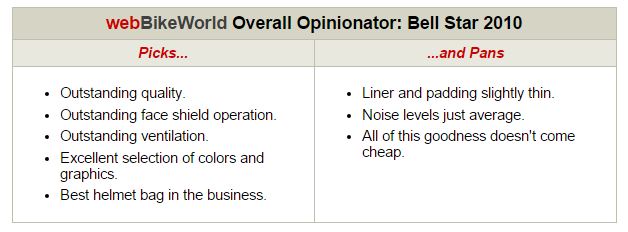
Miscellaneous
The big D-rings used on the Bell Star feel solid and hold the the unique magnetic chin strap end retainer which takes a couple of tries to figure out but works well after that.
Bell Powersports, Inc. gives an excellent 5-year warranty on the helmet, which means that it’s pretty much covered for the expected life of the product.
One important note: The comments in this review are relevant to the 2010 version of the Bell Star helmet. You can tell it’s the 2010 version if it is Snell 2010 approved.
There are still plenty of the 2008-2009 Bell Star helmets in stock, and they’re nice helmets; for more information, see our review of the 2008-2009 Bell Star.
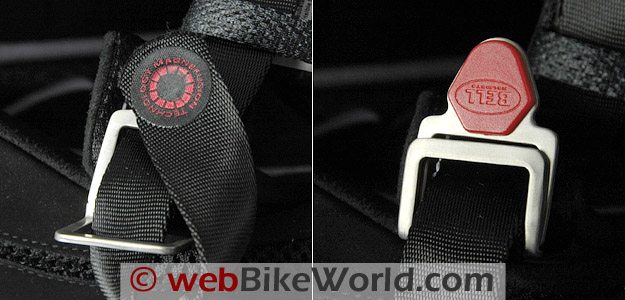
Conclusion
The Bell Star for 2010 has it all together; rarely do we find a helmet that lives up to its promises as this one does.
The quality of the construction, the operation of the face shield and the ventilation are all benchmarks for other manufacturers.
There are very many helmets to choose from in 2010 and we have noted the number of good quality sub-$200.00 helmets also in that group.
Spending more than that on some helmets doesn’t always justify the outcome, but in the case of the Bell Star, you’re much closer to getting the value you paid for.
| wBW Review: Bell Star 2010 Helmet | |
|---|---|
| Manufacturer: Bell Powersports, Inc.. | List Price (2010): $549.95 to $599.95 |
| Colors: Many colors and graphics. | Made In: China |
| Sizes: XS-2XL Shell Sizes: 3 | Review Date: March 2010 |
|
Rating Scale is subjective: Unacceptable, Poor, Neutral, Very Good, Excellent, Outstanding.
|
|
Owner Comments and Feedback
See details on submitting comments.
From “T.S.” (March 2012): “My local Honda dealer had these at 40% off, so I picked one up. An oddity is the inconsistent Bell sizing. I have a 2010 Bell Vortex (review) XL and cannot even get a Vortex L on, but the Star L fits the same as the Vortex XL in width.
While the Vortex is an excellent value, the Star is significantly quieter with less buffeting at speed. The Star also feels much lighter when riding head down on a sport-bike, but the difference is less noticeable on a more upright sport-tourer.
The Vortex will remain my commuter helmet (since I feel less bad about it getting banged up), while the Star will be uses for longer rides, track days, and other sport-bike riding.”
From “J.D.M.” (September 2011): “I have owned the bell star 2010 with the Day of the Dead graphics for about a year and a month and have gathered both positives and negative reviews.
First the Positives:
The quality of the graphics is top notch, no flaws to be see in both art and clear coat.
The inside liner is plush and feels very good against my skin. Ventilation is incredible comparing it to the Shoei RF-1000 I have and as far as noise levels I don’t notice much since I always wear ear plugs.
Wearing the helmet on a daily basis commuting and occasional track days is very comfortable and also feels light.
Head checks are with ease left to right since it feels it is just slicing through air and when you tuck into a racing position your head feels so stable that it made me realize they really did there homework in the aerodynamics department, love it.
Into the negatives…
I had to get a size smaller with the Bell. I normally wear a small in the Shoei line but I wear a XS in the Bell, maybe it’s just the shape of my head.
I’m in the process of filling a warranty claim for a number of reasons. First the magnet cover on the neck strap is coming off which I glued so that the magnet does not fall off.
Next, the interior padding that goes over my head comes undone by the brow area whenever I slip into the helmet, I ignored that by just re attaching the liner by running my fingers across the line of the front of the helmet to snap the liner back in, while wearing the helmet by the way.
Finally, when I removed the left cheek pad for cleaning I found that the hard Styrofoam that forms the inside side of the helmet is coming apart from the main composite helmet shell.
Upon Further inspection I found that it is glued on together in only 2 areas and one is apart already and the other spot is clinging on just barely by the shell, very bad in my opinion.
I really find it hard now to like the Bell Star ( but really I still do) with these problems that I am experiencing but hopefully its an isolated case and confident that Bell would replace this helmet with the backing of there 5 year warranty that they offer, fingers crossed….”
From “S.Z.” (August 2011): “I loved my 2008 black Recoil Bell Star (still do – still have it). So much that I bought a Gobert on closeout a while back. I even broke down and bought a 2010 Star in the green/gold Livin’ Large graphic.
I have to say I think the 2010 fit is much better, but I cannot get my glasses’ temples to rest on my ears. The cheek pads are in the way somehow.
The newer fit is better, the venting still outstanding, but I must say, having 3 Bell Stars from 3 different years I can tell you that Bell’s QA leaves much to be desired. My Gobert fits my head differently than my original Recoil.
Like the EPS is dented inward on top and I can feel it on my Gobert on the top right and left sides. I thought maybe breaking it in would do the trick but that’s not the case.
I also wrote to Bell about my dissatisfaction of the fit of the rear spoiler. The front points are not flush with the helmet, like they are bending away from the glue. Bell offered to send me a new rear spoiler. I say replace or repair it yourself, not me!
I had an issue with a cheek pad snap on my Scorpion EXO 700.
I notified Scorpion and mailed the helmet out. I got it back in 3 days fixed. Not only fixed, but when I sent it I did not send it with the visor. They put a new one on. I contacted them about that and they said a new helmet deserves a new visor. THAT’S customer service!
I am tempted to get an EXO 750. Lighter, cheaper and with the ability to snug it up and kill noise even more than it already does.
Paint on the Gobert is excellent. I prefer the old D-ring chin strap to the fancy-for-nothing magni-confusion technology. It irritates my throat. I can feel it on the Livin’ Large model, and my RS-1 also, as it is wider than a normal D-ring.
I expressed my concern to Bell that this could easily ram into a riders throat in the event of an accident, but at this point they think I am a nag.
The chin curtain on my 2010 Livin’ Large does not stay in place and easily falls out when taking off the helmet. One look at the EPS at the chin and how it’s warped confirms that the shells are not uniformly inspected, IMO.”
From “D.W.” (09/10): “Just a note on the ‘NutrFog II’ anti fog coating on the Star. It really works wonders, and I have finally worn it off in one spot, so had to remove it after about eight months. The thickness is best described as being like scotch tape adhesive, and it’s a bugger to remove.
Now that I’m just using some of the Clarify DeFog It (review), the difference is noticeable. DeFog It is great, don’t get me wrong, but I really would like to know what the NutrFog II stuff is.
It works better than anything I have seen, and when overloaded (on purpose) with heavy breathing on a cold day, it fogs very slowly and evenly.
If I hold my breath for a couple of heartbeats it clears almost immediately. I never leave without the first aid kit and Clarify in my vest, but that NutrFog deserves props!”
From “S.M.” (5/10): “I’ve had this helmet for a few months now but delayed feedback until I switched out the cheek pads.
My jaw area tends to run a size larger in proportion to the rest of the helmet and the original size L helmet cheek pads were causing pain. Switching to a smaller set solved this. Had the same problem with my Arai Profile.
I have a 2010 Star in the Dia De Los Muertos scheme, and let me tell you it looks amazing.
The colors pop, the lines are crisp and there is a metallic flake in the base black that somehow extends into the black plastic of the vents. Very cool.
The liner is fantastic, to me, though the cushion fit is on the firm side compared to my Arai. The visor mechanism is fantastic as are the chunky vent operators and overall the helmet feels light and is very stable at speed.
No problems with the magnet strap holder either. My only issue is the noise, which isn’t terrible but always I’m wishing it was as quiet as my Arai.
With regards to head shape and fit; The most comfortable helmet I’ve tried on would be a Shoei RF-1100 due to its jaw line feel; however, the viewport rested much much lower than I liked. Almost like an AGV.
My Arai Profile is near perfect due to thick inner padding I believe. The Bell Star fits snugly all the way around my crown and just a little high in the back. After the cheek pads were replaced the jaw area is comparable to the Arai.
Overall a fantastic helmet and there is a cool new Cerwinski carbon edition!”
From “J.L.” (5/10): “I’ve just received two new Bell star helmets, one 2008 (Snell M2005) and one 2010 (Snell M2010), both size large.
The 2008-2009 models are currently on closeout and can be found … in limited sizes and designs. I thought I’d take this opportunity to compare the 2008/9 vs. 2010 versions side-by-side.
Liner
The 2010 does not have the stitched seam across the forehead like the original does, as was noted in your review, but the thickness and quality of the liner padding appears to be exactly the same, with only minor changes to the design.
There are minor differences in the ear pocket area, but both have the same removable foam speaker plugs for adding speakers.
The new magnetic strap retainer is wonderful. I’ve read some reviews that say it is not strong enough to stay connected, but I have not had any problems with it so far.
Head Shape
The difference in shape between the two is minor but noticeable. The 2010 Bell Star fits me better than the 2008 which puts slight pressure on my forehead. I’ve tried on (the) Shoei RF-900, TZ-R, RF-1000, RF-1100, and X11.
Every one of them puts too much pressure on my forehead, some worse than others, but easily recognizable as soon as I pull it over my head.
The 2008 Bell Star feels more like a Shoei to me, I would say it’s rounder than the 2010. I’m not sure this concurs with your review. I never could fully understand all the different head shape descriptions, I just know I don’t have a Shoei head.
Bottom line, try it on before you buy, because while the 2010 star fit’s me comfortably for hours, I think the 2008 would cause pain on my forehead after a short time.
Sizing
My head measures right in the middle of a size large on Bell’s size chart. I fit a Large Shoei and XL Arai. I read some reviews that said I should buy a Medium Bell Star, but that’s not the case. The large Star fits me quite well. I think the Bell size chart is accurate based on my experience.
Face Shield
Both new and old Bell Star helmets seem to have the same great face shield and hardware. According to the manual the hardware is titanium, not aluminum. I do have two minor complaints.
Although visor flex seems about average, when I crack it open using the venting lever it flexes and makes a wider gap on the left side with almost no gap on the right. This isn’t really a problem because it still works just fine.
Also, the thin tapered shape of the locking/venting lever makes it difficult to operate while wearing gloves. Besides those two minor gripes, it’s flawless.
Aerodynamics
The Bell Star is rock solid at any speed. Even turning my head to the side at highway speeds I don’t feel any drag or instability. I don’t know how they did it, but the shape just works.
I do notice a little bit of buffeting and slightly more noise when I have a passenger on the bike, but nothing I can’t live with. My 2004 Interceptor dumps lots of dirty air right at chin level
I think this helmet is one of the best values around, especially considering the great bag and extra cheek pads that are included. At the … closeout price(s on the pre-2010 models) there is nothing else that even comes close.”


